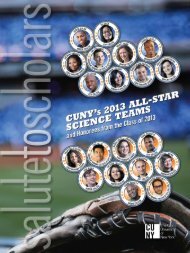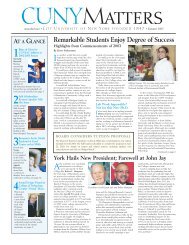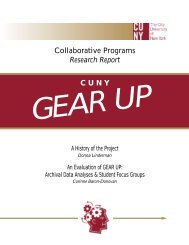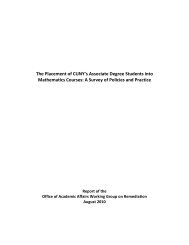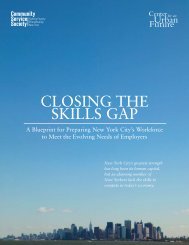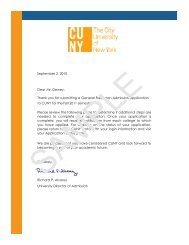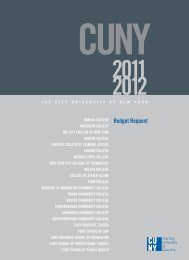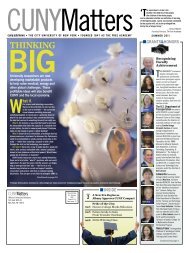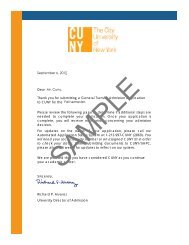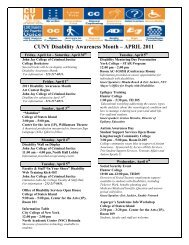CUNY Master Plan 2012-2016
CUNY Master Plan 2012-2016
CUNY Master Plan 2012-2016
You also want an ePaper? Increase the reach of your titles
YUMPU automatically turns print PDFs into web optimized ePapers that Google loves.
MISSION PART FOUR<br />
Unlike the 1972 space guidelines, which are a series of formulas contained in a document and used by a limited<br />
few in master plans or major building projects, the new space guidelines will be an interactive electronic<br />
tool for more efficient management of space on the campuses. This tool is expected to be in use by early 2013.<br />
At a more immediate level, from campus to campus the majority of space types are similar; therefore<br />
<strong>CUNY</strong> takes advantage of its unique five-borough radius when planning renovations and new facilities.<br />
Spaces that function with maximum benefit to the students, faculty or staff are identified and act as models<br />
for future projects. Examples are the LaGuardia Community College Student Information Center and<br />
the Office of Administrative and Information Services at Hunter College. These two sources of enrollment<br />
services have been visited by planning staff from many of the other colleges as examples of how to<br />
make the administrative requirements of attending school easier to navigate.<br />
Additionally, project data are shared through the Capital Improvement <strong>Plan</strong> (CIP) database. CIP is<br />
the tool used by all 24 institutions to request capital projects. It contains the scope, cost estimate, schedule,<br />
justification, and program components of every requested project. CIP allows read-only access by<br />
any <strong>CUNY</strong> college facilities administrator of another college’s data. This eliminates the need to start<br />
from scratch when one institution is considering a project similar to a project recently completed. Furthermore,<br />
cost estimates, square-footage requirements, and timelines are all better projected when<br />
benchmarked against comparable projects.<br />
Turning to innovative procurement approaches, it is essential first to understand that all <strong>CUNY</strong> capital<br />
projects are designed by licensed architects and engineers. In order to acquire these professional services,<br />
<strong>CUNY</strong> has procured design and construction requirement contracts that allow the University and<br />
the colleges to expedite capital projects.<br />
Because <strong>CUNY</strong> is an integrated university, all 24 institutions are able to benefit from the requirement contracts.<br />
Furthermore, work of a similar nature can be bundled across campuses to achieve scale-of-magnitude<br />
savings and to accelerate necessary improvements. To that end, 14 laboratories at eight campuses will be<br />
upgraded using services and construction provided through the requirement contracts. These upgrades will<br />
support the Decade of Science in a more immediate fashion than the large-scale new science facilities at City,<br />
Brooklyn, Lehman, and Hunter Colleges. The specific scope of work is developed for each laboratory with<br />
input from faculty representing their respective colleges. The fast turnaround for these projects—14 months<br />
from design to construction completion—quickly improves life and morale on the campuses.<br />
The requirement contracts have streamlined <strong>CUNY</strong>’s ability to meet facilities needs at the colleges.<br />
The requirement contract solicitation resulted in more than 350 responses. The city’s architecture, engineering,<br />
and construction community is very interested in working with <strong>CUNY</strong>, and this method of<br />
procuring services allows firms to compete fairly for <strong>CUNY</strong>’s capital projects and provides <strong>CUNY</strong> with<br />
contracted firms ready to begin working as appropriations are made and are available for expenditure.<br />
Capital Budget<br />
The capital program has two components: 1) The funded 2011-<strong>2012</strong> Capital <strong>Plan</strong> and 2) the <strong>2012</strong>-2013<br />
Capital Budget Request. The state provides 100 percent of the capital support for the funding for senior<br />
95




